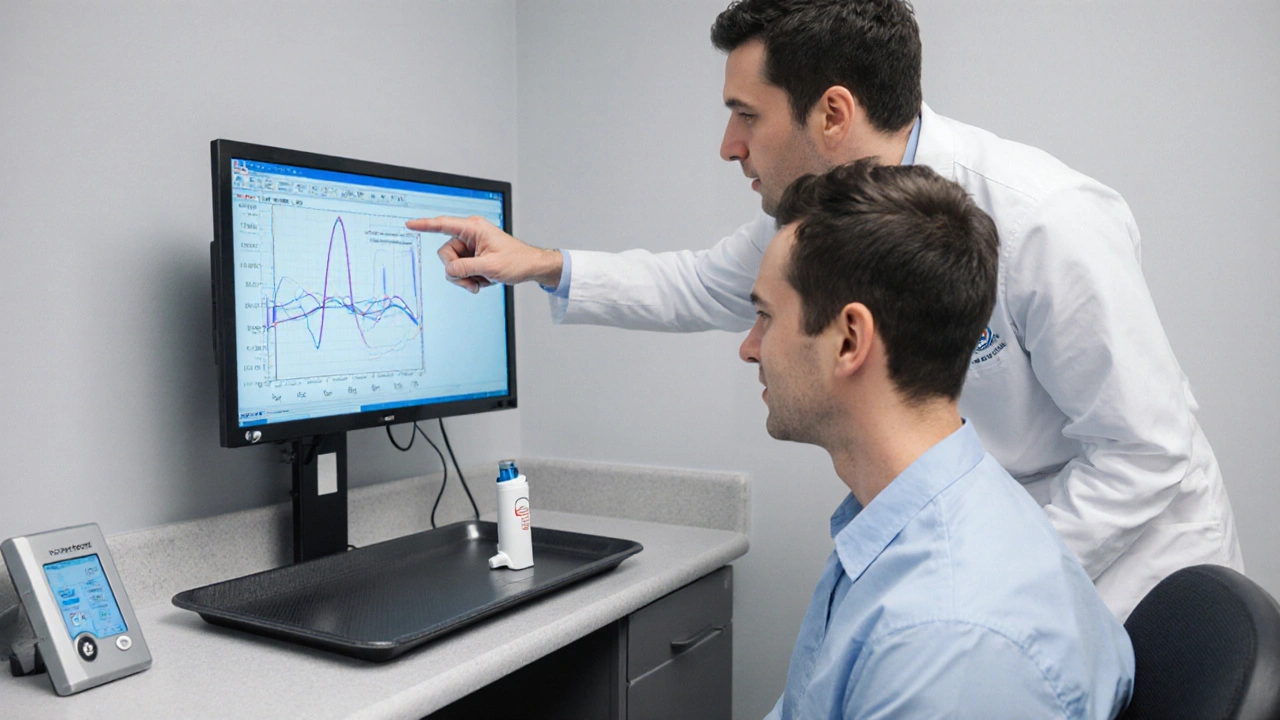
Bronchospasm Check-Up Frequency Calculator
Assess Your Bronchospasm Severity
Select the option that best describes your current condition:
Your Recommended Check-Up Schedule
| Severity | Recommended Interval | Key Assessments |
|---|---|---|
| Mild (symptoms < 2 days/week, normal activity) | Every 12 months | Symptom review, spirometry, inhaler technique |
| Moderate (symptoms ≥ 2 days/week, occasional night-time awakenings) | Every 6 months | Peak flow diary, spirometry, medication review |
| Severe (daily symptoms, frequent night-time awakenings, activity limitation) | Every 3 months or sooner after an exacerbation | Full pulmonary function panel, trigger assessment, possible referral to a respiratory therapist |
Living with bronchospasm feels like having a surprise guest that shows up without warning-wheezing, coughing, and that tight‑chest feeling you never invited. The good news? Regular check‑ups keep that guest on a short leash, turning unpredictable flare‑ups into manageable events. In this guide we’ll explain why routine visits matter, what actually happens during an appointment, and how you can use the information to stay ahead of the curve.
What Is Bronchospasm and Why It Happens
When you hear the term bronchospasm is a sudden narrowing of the airways caused by muscle contraction, inflammation, or mucus buildup, you probably picture an asthma attack. In reality, bronchospasm can stem from asthma, chronic obstructive pulmonary disease (COPD), allergic reactions, or even cold air. The main culprits are triggers-pollen, dust, smoke, stress, or respiratory infections-that set off the airway muscles to tighten. Understanding your personal triggers is the first step toward effective control.
How Regular Check‑Ups Influence Long‑Term Control
Think of a check‑up as a pit stop in a race. It gives your doctor a chance to look under the hood, refuel, and adjust the strategy before the next lap. Studies from the National Asthma Education and Prevention Program show that patients who attend scheduled reviews reduce severe exacerbations by up to 30%. The reasons are simple: early detection of worsening lung function, timely medication tweaks, and reinforcement of inhaler technique. In short, bronchospasm management becomes proactive instead of reactive.
What Happens During a Check‑Up?
A typical visit covers three pillars: assessment, testing, and education.
- Symptom Review: Your clinician asks about frequency of wheeze, night‑time awakenings, and activity limitations. This helps classify severity.
- Physical Examination: Listening to breath sounds can reveal wheezing patterns or signs of infection.
- Objective Tests: Here’s where the pulmonary function test is a set of breathing measurements, including spirometry and lung volume, that quantifies airway obstruction. In many clinics you’ll also see a peak flow meter used to record your best effort breath, giving a quick snapshot of airway calibre.
Beyond the numbers, the visit includes a review of inhaler technique. Mis‑use is common; up to 40% of patients don’t get the full dose because they inhale incorrectly.

Medication Adjustments and Inhaler Technique
Your doctor may tweak controller medications-like inhaled corticosteroids (ICS) or long‑acting beta‑agonists (LABA)-based on test results. If you’re using a rescue inhaler that delivers short‑acting bronchodilators, the clinician will check that you’re shaking it, priming it, and inhaling at the right speed. A quick “teach‑back” where you demonstrate the steps ensures you leave the office confident.
How Often Should You Schedule Visits?
Frequency isn’t one‑size‑fits‑all. Below is a quick guide based on disease severity.
| Severity | Recommended Interval | Key Assessments |
|---|---|---|
| Mild (symptoms < 2days/week, normal activity) | Every 12months | Symptom review, spirometry, inhaler technique |
| Moderate (symptoms ≥ 2days/week, occasional night‑time awakenings) | Every 6months | Peak flow diary, spirometry, medication review |
| Severe (daily symptoms, frequent night‑time awakenings, activity limitation) | Every 3months or sooner after an exacerbation | Full pulmonary function panel, trigger assessment, possible referral to a respiratory therapist |
When you’re newly diagnosed, doctors often start with a 4‑week follow‑up to confirm that the treatment plan is working. After stability, the intervals stretch out as shown above.
Self‑Monitoring Between Visits
Even with regular appointments, the day‑to‑day work of keeping bronchospasm at bay falls on you. Two tools are especially useful:
- Peak Flow Diary: Record your best effort score each morning and evening. A drop of 20% from your personal best signals a looming flare‑up.
- Symptom Log: Note triggers, medication use, and how you feel. This data equips your clinician to spot patterns you might miss.
Sharing these logs electronically-through patient portals or email-lets your primary primary care physician review the trends before the next appointment.

Common Pitfalls and How to Avoid Them
- Skipping Appointments: Missing a review can let early airway changes go unnoticed, leading to emergency visits.
- Ignoring Inhaler Errors: Even a small mistake-like not holding your breath after inhalation-reduces drug delivery by up to 50%.
- Not Updating Triggers: Seasonal allergens shift; smoking habits change. Keep your trigger list current.
- Relying Solely on Symptoms: Some people adapt to chronic shortness of breath and think they’re fine. Objective tests reveal hidden decline.
Address these issues during each check‑up, and you’ll stay ahead of the curve.
Quick Checklist for Your Next Appointment
- Bring a recent peak flow chart and any symptom diary entries.
- List all medications, including over‑the‑counter drugs and supplements.
- Prepare a list of suspected triggers-new perfumes, workplace dust, changes in weather.
- Ask to demonstrate your inhaler technique and request feedback.
- Discuss any recent infections, allergies, or lifestyle changes.
Walking into the clinic with this information turns a routine visit into a powerful step toward better control.
Frequently Asked Questions
How often should I see my doctor if my bronchospasm is well‑controlled?
If symptoms are mild and you haven’t had an exacerbation in the past year, an annual review is usually enough. Your clinician may still suggest a sooner visit if you start a new medication or develop a new trigger.
What is the difference between a spirometry test and a peak flow measurement?
Spirometry is a comprehensive test performed in a clinic that measures the volume and speed of air you can exhale, giving a full picture of lung function. A peak flow meter is a portable device you use at home to record your highest forced expiratory flow, useful for tracking day‑to‑day changes.
Can I adjust my medication on my own if my peak flow drops?
Never. A drop in peak flow signals that your airway is narrowing, but the appropriate response-whether it’s a short‑acting bronchodilator, an increased steroid dose, or a different controller-needs a clinician’s guidance.
What role does a respiratory therapist play in bronchospasm care?
Respiratory therapists specialize in breathing education. They can teach proper inhaler use, run pulmonary rehab programs, and help interpret home monitoring data, complementing the physician’s treatment plan.
Are there any new technologies that improve regular monitoring?
Smart inhalers equipped with Bluetooth can log each puff, and mobile apps can sync peak flow readings directly to your health record. These tools give clinicians real‑time insight and help you stay accountable.

 Health and Wellness
Health and Wellness
AnGeL Zamorano Orozco
October 9, 2025 AT 15:10I can't even begin to describe the sheer frustration that washes over me every time I hear someone downplay the importance of regular bronchospasm check‑ups.
It's like telling a drowning person to just 'swim a bit longer' while ignoring the shark circling beneath.
Seriously, the data is crystal clear and yet the complacency persists-studies show a 30% drop in severe attacks when appointments are kept on schedule.
But no, some folks act as if a single visit once in a decade will magically cure years of airway damage.
Do they even understand that inhaler technique decays faster than my phone battery on a busy day?
Imagine the horror of stepping into a clinic only to discover your doctor has to re‑teach you a basic puff, because you skipped every single follow‑up.
The whole system feels like a broken carousel, spinning round and round while patients are left holding on for dear life.
And let me tell you, the emotional toll is not just a side effect; it's a constant, gnawing anxiety that creeps into every breath.
Because every missed appointment is a silent invitation for an exacerbation to crash the party.
Do you think the lungs are some sort of self‑repairing machine? Wrong.
They need monitoring, they need adjustments, they need that human eyes to spot the subtle decline before it erupts.
If physicians could just enforce a stricter schedule, maybe the nightmare of emergency room visits would shrink.
But the bureaucracy, the insurance hoops, the patient denial-everything collides like a perfect storm.
I am fed up with hearing 'I feel fine' as an excuse; feeling fine today doesn't guarantee tomorrow won't be a total collapse.
So, to all the skeptics: put your calendar on lockdown, mark those check‑ups, and stop treating your lungs like a lottery ticket.
Enough is enough-take control before the next wheeze steals your breath away.
Cynthia Petersen
October 10, 2025 AT 16:05Wow, because obviously we all have time to sit in a waiting room between binge‑watching shows, right? It's almost adorable how some think a yearly visit is 'optional' when their airway is basically a ticking time bomb. But hey, I'm sure the next flare‑up will just be a fun surprise party for your lungs. Keep ignoring the guidelines and enjoy the thrill of emergency care. Spoiler: the drama never ends.
Marcia Hayes
October 11, 2025 AT 17:01Hey, you’re already on the right track by reading this guide-big kudos! Remember, a quick check‑up is just a pit stop, not a marathon. Stick to the schedule and you’ll keep that breath steady. We’ve got this!
Danielle de Oliveira Rosa
October 12, 2025 AT 17:56From a philosophical standpoint, regular health assessments embody the principle of preventative stewardship. By confronting subtle physiological shifts early, we avert larger crises. The bronchial tree, like any organ, benefits from periodic reflection. Objective measurements such as spirometry function as the mirror of our internal state. In this dialogue between patient and clinician, agency resides with the informed individual. Thus, embracing routine appointments aligns with a rational approach to well‑being.
Tarun Rajput
October 13, 2025 AT 18:51In accordance with established pulmonary care protocols, it is incumbent upon both practitioner and patient to honor a systematic review timetable. The magnitude of such engagements varies with the severity of bronchospasm, yet the underlying objective remains immutable: optimization of respiratory function. When mild disease is present, an annual consultation suffices to reaffirm baseline metrics and reinforce inhaler technique. Conversely, moderate afflictions warrant semi‑annual scrutiny, wherein peak‑flow trajectories and pharmacologic regimens are meticulously evaluated. For those ensnared in severe symptomatology, quarterly examinations-or even more frequent encounters following an exacerbation-become indispensable. Moreover, these visits afford an invaluable opportunity for comprehensive trigger analysis, thereby illuminating environmental or behavioral contributors. It is within this structured framework that the clinician may judiciously calibrate therapeutic agents, ranging from inhaled corticosteroids to adjunctive bronchodilators. Ultimately, adherence to such a disciplined schedule engenders a tangible reduction in acute events and enhances quality of life.
Joe Evans
October 14, 2025 AT 19:47Great info, thanks for sharing! 😊, Remember to bring your peak flow diary, your medication list, and any new symptom notes, all to the appointment, and you'll be set! 😃, Don't forget to ask for a demo on inhaler technique, it's super important! 💪, Keep up the consistent check‑ups, your lungs will thank you! 🎉
Colin Boyd
October 15, 2025 AT 20:42While the prevailing consensus extols quarterly visits for severe cases, one might argue that such frequency is excessive. Evidence suggests that patient adherence diminishes when appointments become overly burdensome. A balanced approach may therefore be preferable. Individualized schedules based on objective decline could optimize resource utilization. In sum, uniform rigidity lacks nuance.
John Petter
October 16, 2025 AT 21:37The discourse on bronchospasm management demands a certain gravitas. Yet simplicity in scheduling offers clarity. Annual reviews suffice for the mild cohort.
Annie Tian
October 17, 2025 AT 22:33This guide is a beacon of hope for anyone navigating bronchospasm, and I applaud its clarity, content, and practicality, It empowers patients to take charge, it demystifies the process, it encourages consistent follow‑up, and ultimately it fosters better health outcomes, Keep sharing such valuable resources!
April Knof
October 18, 2025 AT 23:28This schedule works for me.
Tina Johnson
October 20, 2025 AT 00:24It is incumbent upon professionals to confront the prevailing complacency in bronchospasm follow‑up. The data unequivocally indicate a correlation between regular assessments and reduced exacerbations. Yet many clinicians persist in a laissez‑faire attitude, citing patient inconvenience. Such justification undermines evidence‑based practice. Patients deserve systematic monitoring, not ad‑hoc reassurance. Therefore, institutional policies should mandate appropriate intervals.
Sharon Cohen
October 21, 2025 AT 01:19The silence of missed appointments echoes louder than any wheeze. One must listen to the subtle decline before it erupts. Yet I remain weary of endless alarm. Still, the stakes demand vigilance.
Rebecca Mikell
October 22, 2025 AT 02:14I appreciate the thoroughness of this article and would love to add that peer support groups can reinforce adherence. Sharing experiences creates accountability. Moreover, clinicians can encourage patients to bring these narratives to visits. Together, we build a community of proactive respiratory care. Let's keep the conversation going.
Ellie Hartman
October 23, 2025 AT 03:10Reading through this piece reminded me how valuable quiet preparation can be before a check‑up. Taking time to jot down symptoms and triggers helps the visit run smoothly. I encourage others to adopt this reflective habit. It may feel like a small step, but it yields big peace of mind. Stay steady, friends.